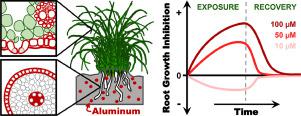Flora ( IF 1.7 ) Pub Date : 2021-03-22 , DOI: 10.1016/j.flora.2021.151803 Anna Kisiala , Sarah J. Bogart , Hai Ngoc Nguyen , Ewa Cholewa

|
Previous observations of Eriophorum vaginatum L. growing in its natural habitats suggest that this perennial graminoid is highly tolerant of aluminum (Al). Eriophorum vaginatum is unusually productive in the bogs surrounding Sudbury (Ontario, Canada) where many years of intensive mining and industrial activities resulted in strong acidification of the environment and wide-scale deposition of metals including highly phytotoxic Al, which in acidic soils is readily available for biological uptake. The ability to accumulate Al within the plant body might be the way of detoxification and can play an important role in Al tolerance by E. vaginatum. To detect Al distribution in leaves, corms and roots of E. vaginatum, plants were collected from a highly polluted site and the fluorescence intensity from the Al-lumogallion complex was observed using a confocal laser scanning microscopy (CLSM). A strong fluorescence signal was detected, demonstrating dense Al accumulation mainly within the cell walls of the analysed plant tissues. It suggests that E. vaginatum can sequester the phytotoxic Al away from the metabolically active tissues so it cannot interfere with the normal cellular activity. Additionally, a hydroponics study was conducted to examine Al effects on root growth and recovery using in vitro regenerated E. vaginatum plants not previously exposed to Al. Root growth was stimulated by 5 and 10 µM Al, but was inhibited by 50 and 100 µM Al. However, all roots returned to control growth rates within 48 h after being transferred to Al-free media, regardless of initial exposure concentration. Based on the ability of this species to tolerate and sequester Al, our results support investigation into E. vaginatum to phytoremediate metal polluted wetlands.
中文翻译:

铝在阴道内组织中的定位及其对根系生长和恢复的影响
以前在自然栖息地中生长的Eriophorumputumtum L.的观察表明,这种多年生的类蠕虫对铝(Al)具有高度的耐受性。阴道Eriophorum在萨德伯里(加拿大安大略省)周围的沼泽中生产异常,那里多年的密集采矿和工业活动导致环境强烈酸化,金属大量沉积,包括在酸性土壤中容易产生的具有高度植物毒性的铝用于生物吸收。在植物体内积累铝的能力可能是排毒的方式,并在阴道大肠杆菌对铝的耐性中发挥重要作用。检测铝在阴道大肠杆菌的叶,茎和根中的分布,从高度污染的位置收集植物,并使用共聚焦激光扫描显微镜(CLSM)观察Al-发光蛋白复合物的荧光强度。检测到强荧光信号,表明主要在被分析植物组织的细胞壁内密集的铝积累。这表明阴道大肠杆菌可以将植物毒性铝从代谢活跃的组织中隔离出来,因此它不会干扰正常的细胞活动。此外,进行了一项水培研究,研究了使用体外再生的阴道大肠杆菌对铝对根生长和恢复的影响。以前未暴露于Al的植物。5和10 µM Al刺激了根的生长,但50和100 µM Al抑制了根的生长。但是,无论初始暴露浓度如何,所有根在转移到无铝培养基后48小时内都恢复了控制生长速度。基于该物种耐受和隔离铝的能力,我们的结果支持对阴道大肠杆菌进行植物修复金属污染的湿地的研究。











































 京公网安备 11010802027423号
京公网安备 11010802027423号